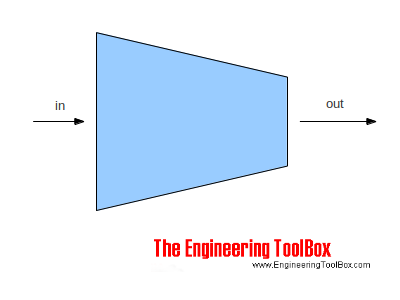Fluid Flow - Equation of Continuity
The Equation of Continuity is a statement of mass conservation.
The Law of Conservation of Mass states that mass can be neither created or destroyed. Using the Mass Conservation Law on a steady flow process - flow where the flow rate do not change over time - through a control volume where the stored mass in the control volume do not change - implements that
- inflow equals outflow
This statement is called the Equation of Continuity. Common application where the Equation of Continuity are used are pipes, tubes and ducts with flowing fluids or gases, rivers, overall processes as power plants, diaries, logistics in general, roads, computer networks and semiconductor technology and more.

The Equation of Continuity and can be expressed as:
m = ρi1 vi1 Ai1 + ρi2 vi2 Ai2 + .... + ρin vin Ain
= ρo1 vo1 Ao1 + ρo2 vo2 Ao2 + .... + ρom vom Aom (1)
where
m = mass flow rate (kg/s)
ρ = density (kg/m3)
v = speed (m/s)
A = area (m2)
With uniform density equation (1) can be modified to
q = vi1 Ai1 + vi2 Ai2 + .... + vin Ain
= vo1 Ao1 + vo2 Ao2 + .... + vom Aom (2)
where
q = flow rate (m3/s)
ρi1 = ρi2 = . . = ρin = ρo1 = ρo2 = .... = ρom
For a simple reduction (or expansion) as indicated in the figure above - the equation of continuity for uniform density can be transformed to
vin Ain = vout Aout (3)
or
vout = vin Ain / Aout (3b)
Example - Equation of Continuity
10 m3/h of water flows through a pipe with 100 mm inside diameter. The pipe is reduced to an inside dimension of 80 mm.
Using equation (2) the velocity in the 100 mm pipe can be calculated
(10 m3/h) (1 / 3600 h/s) = v100 (3.14 (0.1 m)2/ 4)
or
v100 = (10 m3/h) (1 / 3600 h/s) / (3.14 (0.1 m)2/ 4)
= 0.35 m/s
Using equation (2) the velocity in the 80 mm pipe can be calculated
(10 m3/h) (1 / 3600 h/s) = v80 (3.14 (0.08 m)2/ 4)
or
v80 = (10 m3/h) (1 / 3600 h/s) / (3.14 (0.08 m)2/ 4)
= 0.55 m/s
Equation of Continuity Calculator
The calculator below is based on eq. 3b and can be used for fluids with uniform density - typical liquids like water, oil and more.



